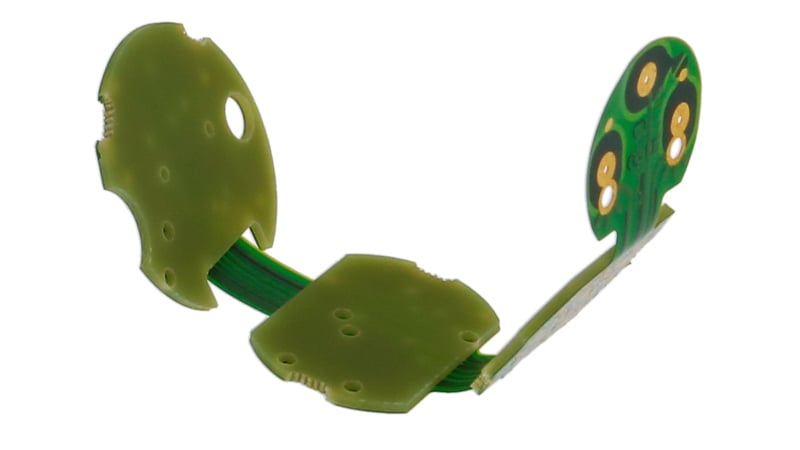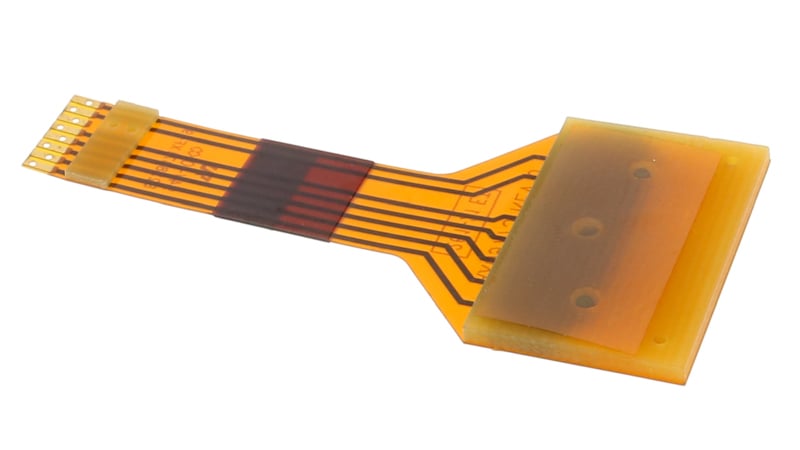Flexible printed circuit boards are a type of printed circuit board (PCB) that has been designed to be more flexible than traditional rigid printed circuit boards. They offer many advantages over their traditional counterparts, including greater design flexibility, improved reliability, and increased cost savings.
In this blog post, we will discuss the benefits of flexible PCBs and how they are used in a variety of applications.

Flexible PCB with stiffeners.
Advantages of Flexible Circuit Boards
The biggest advantage of flexible circuit boards is their flexibility. Traditional PCBs are rigid and limited in size, shape, and design options. Flexible PCBs can be designed to fit into tight spaces or can be shaped to follow curves or contours for better ergonomics or aesthetics. This allows for more creative designs which can help increase the efficiency of products or make them easier to use.
Flexible PCBs also have higher reliability than rigid PCBs due to their improved mechanical properties. The flexible substrate material is able to absorb shock and vibration better than traditional rigid circuit board materials, leading to improved product lifetimes and fewer failures during operation. Additionally, flexible PCBs also have improved electrical performance due to reduced signal loss associated with bending or flexing the board during operation. This leads to higher signal integrity and faster data rates compared to traditional PCBs.
Types of Stiffeners
Stiffeners are additional components that are attached to a flexible PCB in order to enhance its rigidity or strength. They are typically made of metal but can also be made from other materials such as plastic or carbon fiber depending on the application requirements. Stiffeners provide support for components mounted on the board as well as provide a more stable platform for soldering connections.
There are two main types of stiffeners: adhesive-backed and rigid. Adhesive-backed stiffeners are typically made of thin metal sheets that have an adhesive backing applied during the manufacturing process so they can be easily attached to the PCB surface. This type of stiffener is most commonly used when a high degree of flexibility is required or where there is limited space available for mounting components. Rigid stiffeners on the other hand provide greater rigidity but require more space for installation and may not be suitable for applications requiring flexibility. The material used for rigid stiffener depends on the application requirements, but it usually consists of thick metal foil or metal plates with cutouts designed specifically for mounting components onto them.
Benefits Of Using Stiffeners
Using flex or rigid stiffener provides several benefits, including improved durability, better performance in extreme conditions, increased rigidity which helps prevent warping when subjected to thermal cycling (heating and cooling), increased shock and vibration resistance which leads to fewer failures due to mechanical stress, improved electrical performance by preventing electrical shorts between layers caused by movement and bending and finally improved electromagnetic interference (EMI) shielding effectiveness by providing an additional shield against external radio frequency (RF) waves entering into the system and causing disruption/interference with other nearby devices/components connected within it.
Stiffeners can also provide rigidity and support to component areas to prevent bending of flex in component areas and potential solder joint damage. Stiffeners are typically made from metal or plastic and are used in combination with components to strengthen specific areas. For example, stiffeners might be used along the edges of a circuit board where components have been soldered onto it. The stiffener provides additional support so that when the board is handled or pressure is applied, the solder joints remain intact. In addition, they can also be placed on top of components to prevent them from shifting during assembly or use.
Stiffener Materials
FR4
FR4 is a fiberglass-reinforced epoxy laminate material that is widely used as a stiffener material. It is composed of a woven glass fabric that is impregnated with epoxy resin to create a composite material. It is a rigid material and has good insulation properties. It is used in a variety of applications including circuit boards, microelectronics, and structural components. The material is also flame-retardant, making it a good choice for high-temperature environments.

Flexible circuit board with FR4 stiffeners.
Polyimide
Polyimide is a type of high-temperature, thermally and chemically resistant polymer that is often used as a stiffener material. It is a highly durable material that is extremely resistant to chemical solvents, acids and bases, and other harsh environmental conditions. It is also resistant to temperatures up to 250°C and can be used in both high and low temperatures. Polyimide is a great choice for stiffeners in applications such as automotive parts, medical components, and aerospace components.
Stainless Steel
Stainless steel is a type of metal alloy that is composed of iron and at least 10.5% chromium. It is a strong and durable material that is resistant to corrosion, rust, and other environmental conditions. Stainless steel is often used as a stiffener material due to its strength and durability. It is often used in applications such as medical instruments, aerospace components, and automotive parts.
Aluminum
Aluminum is a lightweight metal that is often used as a stiffener material due to its strength and durability. It is a non-magnetic, corrosion-resistant material that is resistant to most environmental conditions. It is also a good thermal conductor, making it a great choice for applications that require heat transfer. It is often used in applications such as aerospace components, automotive parts, and medical instruments.
Increasing Thickness to Meet ZIF Connector Specification
This is an important step when manufacturing components that require this type of connector. The connector itself has two components, the insert, and the contact. The insert is typically made of metal or plastic and contains a pin that interacts with the contact to create an electrical connection. The contact is usually made of metal or plastic and contains a spring-loaded plunger that interacts with the pin on the insert to create an electrical connection.
To ensure that these two components are able to make consistent, reliable connections, they must be mated together properly. This means that the proper amount of force must be applied during assembly in order for them to stay connected. Too much force can damage the components, and too little can cause them not to make a secure connection.
In order for a ZIF connector to work properly, it needs to have an increased thickness in its localized area. This means that there must be enough material for both parts – not too much and not too little – so they can connect securely without damaging either component. To achieve this, manufacturers often use processes such as machining or stamping which allow precise control over material thickness within certain tolerances required by the specifications laid out by ZIF connectors’ manufacturers.
Dissipate Heat with an Aluminum Stiffener
Heat dissipation is an important factor in many engineering applications, particularly in electronics and other sensitive components. One of the most effective ways to dissipate heat is to use an aluminum stiffener, which is a metal plate with an enlarged surface area to dissipate heat more quickly.
An aluminum stiffener is a plate made of aluminum, which is a highly conductive metal. This means that it's extremely efficient at transferring heat away from the source. Aluminum is also lightweight and relatively inexpensive, making it a great option for many applications.
When using an aluminum stiffener, it's important to consider the size and shape of the plate, as well as the thickness. The size and shape of the plate will determine how much surface area is exposed to the air, and the thicker the plate, the greater the thermal conductivity. The design should also be optimized to ensure that the aluminum is in direct contact with the surface it's dissipating heat from.
In addition to the size, shape, and thickness of the plate, the type of aluminum used can also affect the efficiency of heat dissipation. Different types of aluminum have different thermal conductivities, so it's important to select the type that best suits the application.
When installing an aluminum stiffener, it's important to ensure that it's securely mounted and that it's not in direct contact with any other components that could be damaged by the heat. The mounting should also allow for easy removal and replacement, in case of damage or wear and tear.
Finally, once the aluminum stiffener has been installed, it's important to monitor it and make sure that it's working correctly. This includes checking the temperature of the plate itself, as well as ensuring that the air around it isn't becoming too hot. If the plate gets too hot, it may need to be replaced or additional cooling measures may need to be taken, such as fans or other cooling devices.
Using an aluminum stiffener is an effective way to dissipate heat, particularly in electronics and other sensitive components. When designing a system that requires heat dissipation, it's important to consider the size, shape, thickness, and type of aluminum to be used, as well as the mounting and monitoring of the plate itself. With proper design and installation, an aluminum stiffener can help ensure that the system stays cool and runs smoothly.
Summary
Flexible circuit boards need stiffeners to help with shock and vibration resistance, improved electrical performance, and improved EMI shielding effectiveness. Stiffeners are typically made of metals such as FR4, polyimide, stainless steel, or aluminum, and the selection of the material should be based on the application requirements. Adhesive-backed stiffeners are typically used when a high degree of flexibility is needed, while rigid stiffeners are used when maximum rigidity is desired.
Additionally, increasing thickness to meet ZIF connector specifications and using an aluminum stiffener to dissipate heat are two important considerations when designing systems that require flexible circuit boards. Please feel free to contact Epec to discuss your specific needs and to have your design requirements reviewed to ensure the effectiveness of your design.
Key Takeaways
- Flexible PCBs benefit from stiffeners: While flex circuits offer design freedom and reliability, stiffeners add localized rigidity to support mounting, soldering, and component stability.
- Different stiffener types exist: Adhesive-backed stiffeners provide flexibility for tight spaces, while rigid stiffeners offer greater strength but require more installation room.
- Material choice is application-specific: Common stiffener materials include FR4 for rigidity and insulation, polyimide for chemical and temperature resistance, stainless steel for durability, and aluminum for lightweight heat dissipation.
- ZIF connectors require controlled thickness: Stiffeners ensure flex circuits meet strict thickness tolerances for ZIF connectors, enabling reliable electrical connections without damaging components.
- Aluminum stiffeners aid thermal management: By conducting and dissipating heat efficiently, aluminum stiffeners help prevent overheating in sensitive electronic assemblies.
















